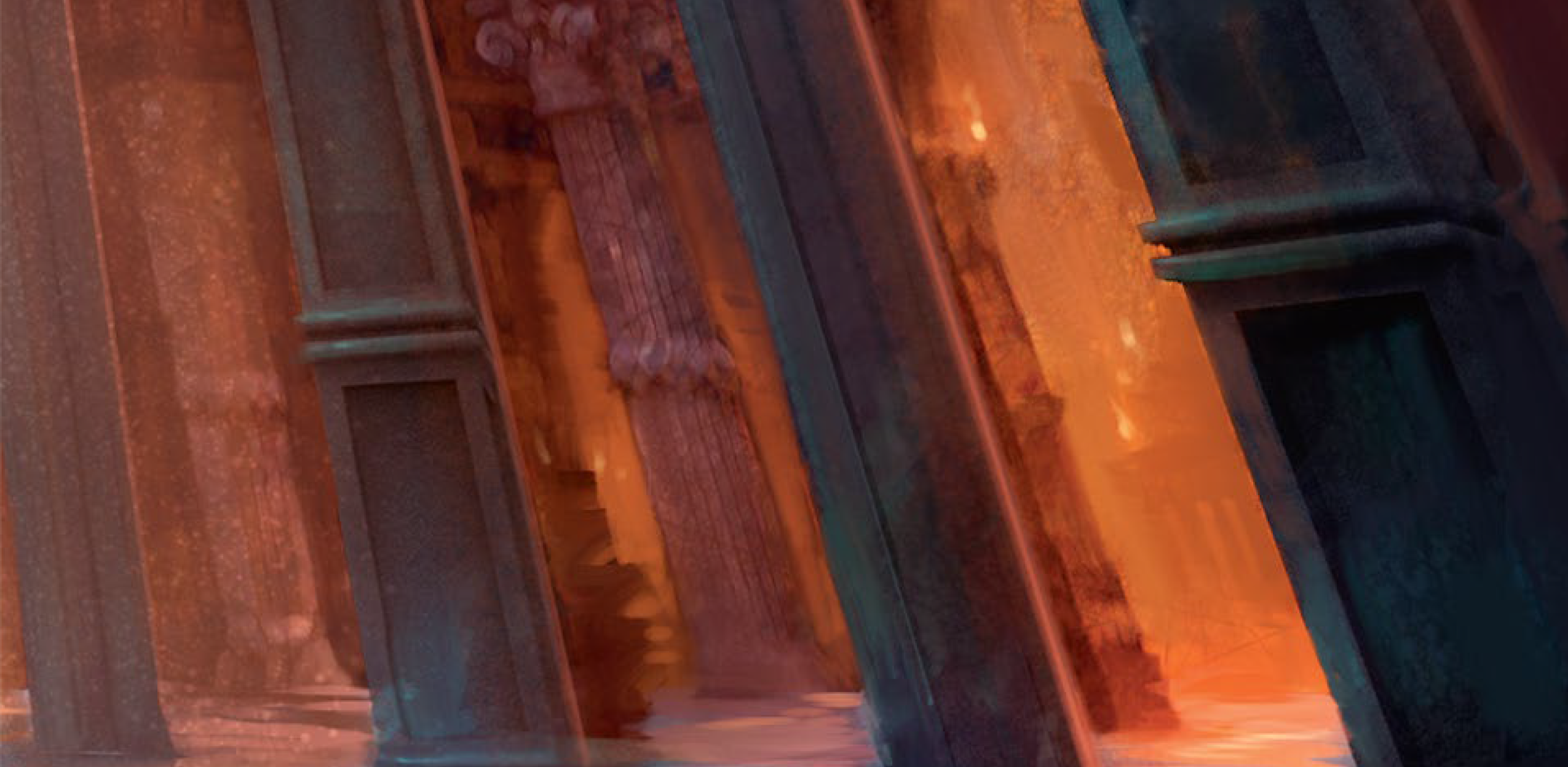The next three adventures – Maddening Screams, Honors Unforeseen, and In the Hand – form the Doors and Corners series.
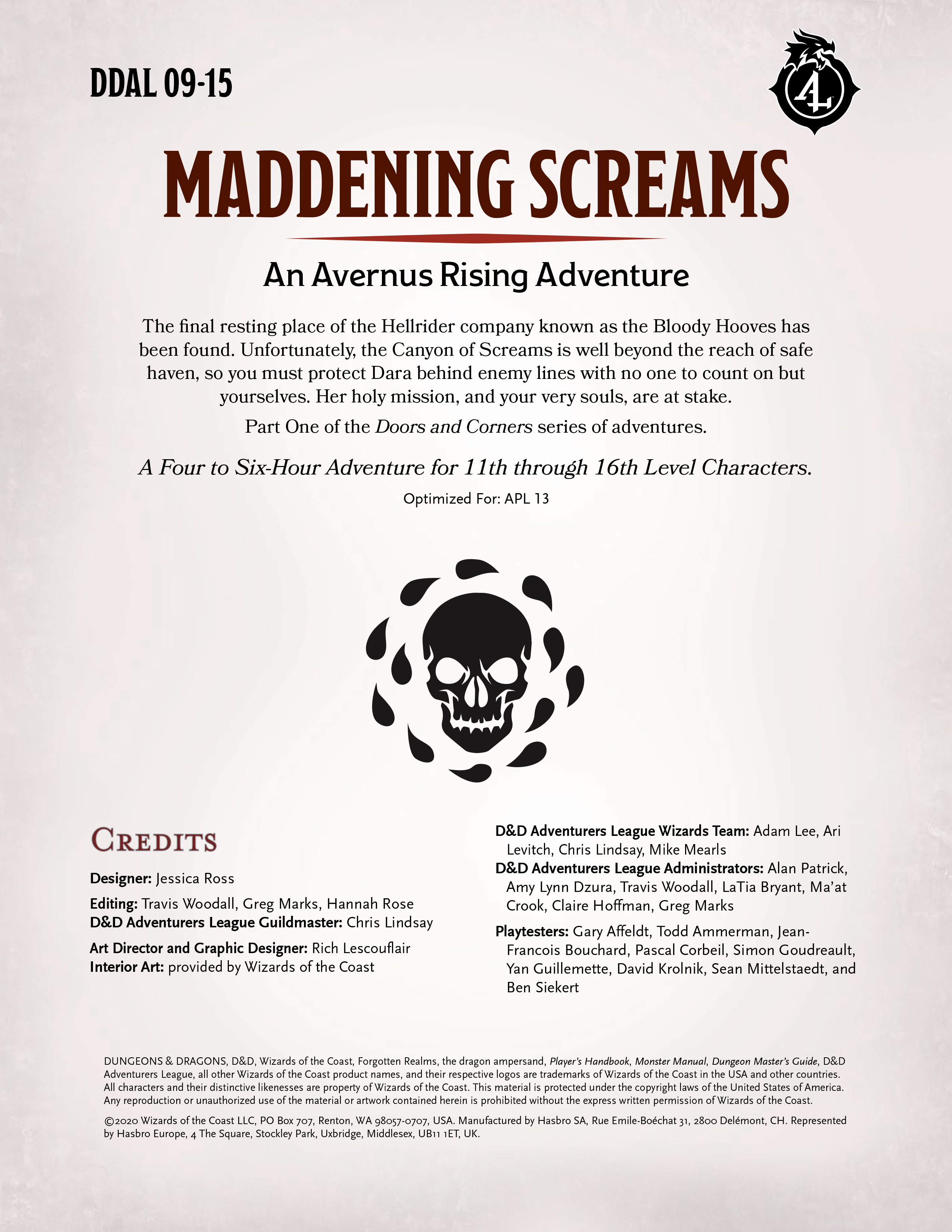 MADDENING SCREAMS (DDAL 09-15): “Meanwhile, Zariel’s forces have taken note of the repeated interference of the adventurers in her plans.”
MADDENING SCREAMS (DDAL 09-15): “Meanwhile, Zariel’s forces have taken note of the repeated interference of the adventurers in her plans.”
I know I’m something of a broken record when it comes to the shoddy cross-continuity of these adventures, but I do invite you to briefly peruse the previous adventures and ask yourself, “What plans, exactly? And when have the PCs done anything to interfere with them?”
In any case, the main thrust of Maddening Screams is that the PCs have recovered the battleplans of the Bloody Hooves, a company of knights who rode with Zariel into Hell. These battleplans said that if the Bloody Hooves were forced to retreat, then they should retreat into a box canyon.
Which, to be blunt, would be literally the LAST place you could possibly want to retreat into.
Also, it turns out the canyon was haunted and all the knights were driven mad.
So the PCs head to the Canyon of Screams to track down the Bloody Hooves. The structure for this, broadly speaking, is mass illusionism: Make a bunch of choices, absolutely none of which matter because “all tunnels eventually lead to the Bloody Hooves.” Sneak past somebody? They find your tracks, catch up, and attack you. Pick a tunnel? Something totally random happens to you. Repeat until the DM arbitrarily declares that you’ve picked the right tunnel this time.
At the end of that arbitrary tunnel the PCs will find an elaborately locked door which (checks notes) opens when literally anyone touches it. Huh. Like putting an automatic door on a bank vault.
Beyond the door, they do the random tunnel thing again, but this time there’s a puzzle they have to solve to find the right path. (The puzzle is… not very good. At each intersection, there are four symbols written on the wall. What these symbols are is not specified, but one of them will match a sentence written on the wall. For example, at the intersection that says, “May your sword strike true,” you have to pick the tunnel labeled with the symbol of a sword.)
Open another automatic vault door and, at long last, you have reached… more random tunnels. Their navigational choices are, once again, completely irrelevant, with the DM instead rolling 2d4 to determine how many tunnels they have to say they’re walking down before reaching the next section of the adventure.
Despite the players passing through locked doors that haven’t been opened in centuries, the devils pursuing them are inexplicably always in the chambers ahead of them. This, of course, makes no sense, but by this point your brain has probably given up on rational thought in self-defense.
The adventure wraps up when the PCs discover that all the Hellriders have inexplicably turned into stone tablets (???) which Dara raises from the… dead? Sure, let’s say dead.
The Hellriders tell the PCs that this is a cliffhanger and the adventure continues in DDAL 09-16.
- Grade: F
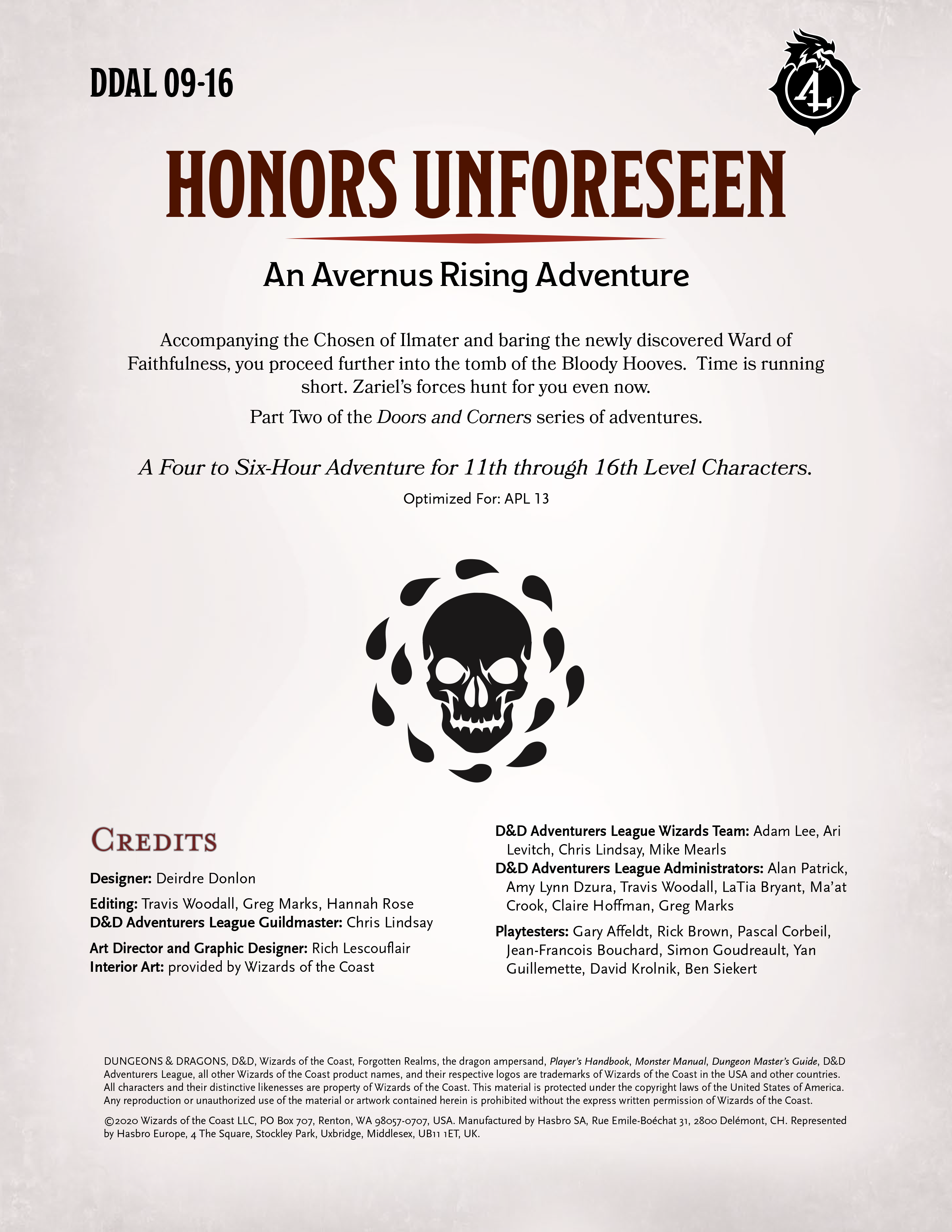 HONORS UNFORESEEN (DDAL 09-16): Honors Unforseen opens with the “super security doors that open if literally anyone touches them” gimmick and then the PCs proceed further into the dungeon to save the clerics who had ridden with the Bloody Hooves.
HONORS UNFORESEEN (DDAL 09-16): Honors Unforseen opens with the “super security doors that open if literally anyone touches them” gimmick and then the PCs proceed further into the dungeon to save the clerics who had ridden with the Bloody Hooves.
A good portion of the problems these adventures have can be summed up as: Don’t design a dungeoncrawl without a map. The convolutions these authors are going through to design incredibly bad dungeons that de-protagonize the PCs is kind of nuts. (I’m straight up blaming the long-term decay caused by D&D no longer teaching people how to design or run dungeons, but seeing it in official adventures really emphasizes how bad it’s gotten.)
As another example of the disconnect between design and table experience, after passing through the world’s worst vault door, the PCs enter a 100 foot long passage:
A number of tiles are trapped with a symbol. There is no rhyme or reason to the symbols’ placement. For each 5 feet that a creature moves through the area, roll a d20. If the result is 15 or higher, they pass over a symbol, triggering it unless they’re a wood elf or Yalanue herself.
Ho-ho-holy shit! Notice that it’s not per 5 foot square; it’s per creature moving 5 feet. So if you’ve got a group of five PCs, go ahead and roll that d20 one hundred times, generating on average thirty random symbols. What an amazing experience that will be at the table!
This installment of Doors and Corners also emphasizes how absurd the entire premise is: The Bloody Hooves fled from battle, retreated into a box canyon, and then… engaged in major infrastructure projects? They even painted elaborate murals on the walls! We’re told this was all made possible by Horst Atheraice… who later turns out to be a 9th level spellcaster who definitely can’t have done all this through his magic.
- Grade: F
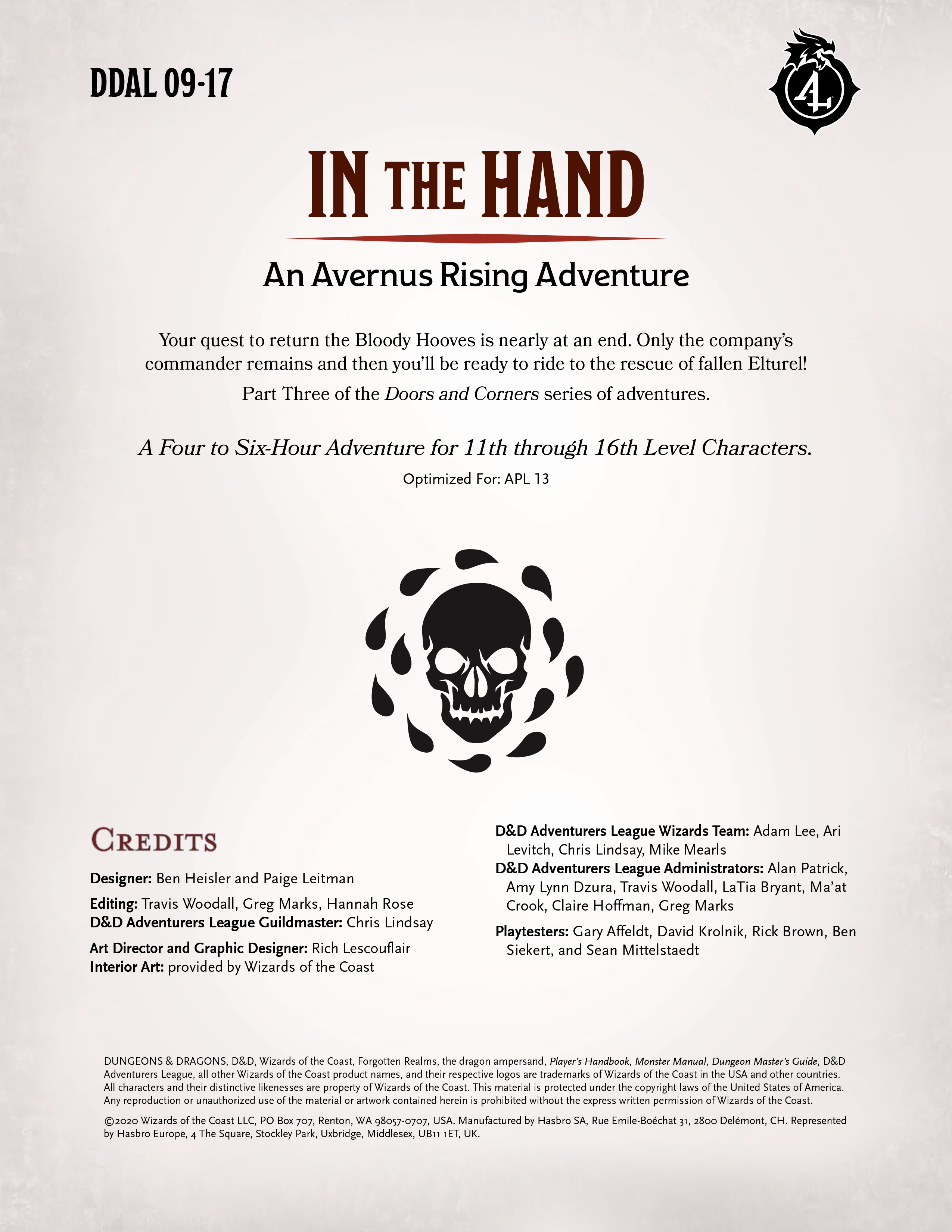 IN THE HAND (DDAL 09-17): In the previous two adventures the PCs have rescued all the knights of the Bloody Hooves and then all the clerics of the Bloody Hooves. In this adventure, the PCs discover that there’s a third level to this dungeon (behind yet another automatic vault door) in which the Commander of the Bloody Hooves was entombed.
IN THE HAND (DDAL 09-17): In the previous two adventures the PCs have rescued all the knights of the Bloody Hooves and then all the clerics of the Bloody Hooves. In this adventure, the PCs discover that there’s a third level to this dungeon (behind yet another automatic vault door) in which the Commander of the Bloody Hooves was entombed.
Horst Atheraice will tell the PCs:
The third level of the tombs is the most dangerous of all. The constructors wove trials into the tombs to ensure that only the most loyal and strong Bloody Hooves could reach the commander.
Oh! Great! Y’all built these defensive wards! What are they?
Past that, they can’t recall anything else about the defenses.
Wow! That’s incredibly convenient amnesia!
Well, that’s okay. You said that you built these defenses specifically so that Bloody Hooves could bypass them. So I guess y’all will be heading down there, then?
No? You’re all leaving and sending us instead? By ourselves?
…
Look, I understand that this is an Adventurers League scenario and it carries with it the expectation that the players will accept the Call to Action. But that’s precisely why you shouldn’t design the Call to Action so that it egregiously insults the players’ intelligence.
![Thanks for helping us! We built these defenses so that only we could bypass them. / So you're going to help us through, right? / [sinister look] / You're going to help us through, right?](https://thealexandrian.net/images/20210621.png)
By the way, there’s also an absolutely stunning mechanic in these adventures: The PCs are frequently escorting Dara. If they fail to protect her and she dies, she instantly resurrects but she randomly loses one of her four divinely gifted powers. If she dies four times and loses all four powers, she also loses the ability to resurrect angels and Hellriders.
If Dara dies during an adventure, the players are given the You Let Dara Die story award which keeps track of how many times they let Dara die.
Now, you might notice that the entire premise of these adventures is that the PCs are taking Dara to the varied corpses of the Hellriders so that she can resurrect them.
Which means it’s quite possible for a player to play this scenario at a convention or gaming club and immediately discover that, due to the other members of the group, the scenario simply can’t be played. (Oddly, none of the adventures give any guidance on how the “Dara raises people from the dead” scenarios should play out if Dara loses the ability to raise people from the dead.)
Anyway, the PCs go down by themselves and discover that, in order to protect their Commander’s corpse, the Hellriders… killed a bunch of their fellow knights and turned them into undead puppets who will perform small interactive morality plays so that would-be tomb robbers can “prove” they have morals.
…
What the actual fuck?
There’s also an absolutely bizarre meta-puzzle which works like this:
- After building an elaborate tomb, killing their fellow knights, and then turning them into undead to staff it, the Bloody Hooves installed text mosaics in every room providing the answer to the puzzle and/or interactive morality play in that room.
- However, the devils have somehow gotten here ahead of the PCs again, and they’ve been smashing the mosaics in each room after using them to solve the puzzles.
- So in the first room the PCs find the smashed remnants of the mosaic and what they do is:
Next to the door is a mosaic that has been shattered, with letter tiles littering the floor. Characters who collect the letter tiles can use them to puzzle out the challenges when they enter the Tomb of Trials.
It’s possible your brain broke while reading that, so let me just reiterate: The PCs take the unassigned letters from one random word scramble and then they use those to solve completely unrelated word scrambles.
I don’t even know if this puzzle can actually be solved, because they forgot to include the solution for it.
To be brutally honest, I gave up on In the Hand before finishing it. I skimmed ahead to determine that the adventure ends with the devils kidnapping Commander Rotger’s corpse.
- Grade: F
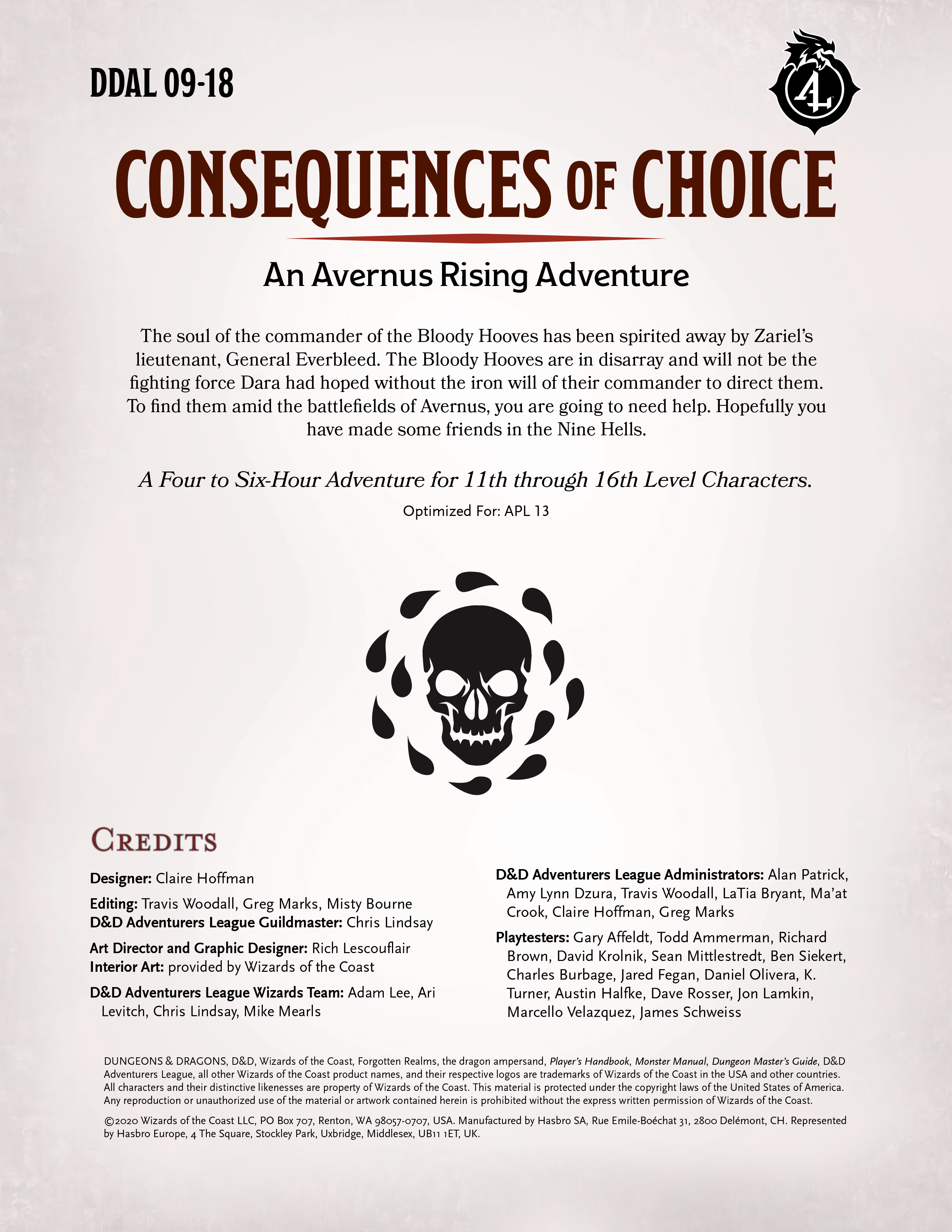 CONSEQUENCES OF CHOICE (DDAL 09-18): Although not technically part of the Doors and Corners series, Consequences of Choice follows immediately on from the events of In the Hand. Rather than following the tunnel the devils dug to grab Commander Rotger’s corpse, Dara decides that the best place to find a lead to the corpse’s location is back at Mahadi’s Wandering Emporium.
CONSEQUENCES OF CHOICE (DDAL 09-18): Although not technically part of the Doors and Corners series, Consequences of Choice follows immediately on from the events of In the Hand. Rather than following the tunnel the devils dug to grab Commander Rotger’s corpse, Dara decides that the best place to find a lead to the corpse’s location is back at Mahadi’s Wandering Emporium.
Unfortunately, the Wandering Emporium has wandered off, so the PCs have to first track it down. To do this they have to make a DC 15 Wisdom (Perception) check… and I guess if they fail, they just can’t find the Emporium and the rest of the adventure doesn’t happen?
In any case, along the way the PCs discover that there’s a demon army which has crossed the Styx and is looking to attack the Emporium. Consequences of Choice is about the PCs helping Mahadi mount a defense.
This defense – and thus the adventure – is built entirely around a mechanical mini-game which, as far as I can tell, received zero playtesting and even less critical thinking.
The way it works is that the PCs have 150 minutes to create defenses which earn them Survival Points. If they can get 45 Survival Points all the named characters live; if they get fewer points than that, people start dying during the fight. They can earn points by:
- Spending 150 minutes to build a siege engine = 5 points
- Spending 20 minutes to make a trap/obstacle = 3 points
- Casting a defensive spell = 2 points
You can immediately see the ludicrous lack of balance here. The DM is told to “reward creative thinking,” but this is completely unnecessary because the default group of five characters can just spend all their time making traps and generate 110+ points.
The system also includes adjustments for variant groups, but these are also laughably bad:
- If the group has fewer than 5 characters, the required number of Survival Points is reduced to 40. But, as we’ve seen, each character can trivially generate 21+ points, which is absurdly out of sync with the 5 points adjustment being made to the target. (The adjustment is also applied in reverse – increasing the Survival Points to 50 if there are more than 5 characters.)
- If the group’s APL is lower than 13, the points required are reduced by 3. If the APL is higher than 13, it’s increased by 3. (This is doesn’t make any sense at all because APL has no effect on the Survival Points generated by various activities.)
But that’s not all! The adventure includes two bonus objectives, each of which can generate 6 Survival Points.
But if the DM decides the group is going to do the bonus objectives, they only get 45 minutes (instead of 150 minutes) to make defensive preparations. In a standard five member group, this drops your group output from 110+ points to just 42 points… which means you fail and somebody dies. (In practice you can probably make that up by casting a couple defensive spells, assuming you have them prepared, but the point is that the system is so badly designed that it systemically discourages DMs and players from playing the full adventure.)
I can’t emphasize enough that this entire scenario is fundamentally built around this system, which I would not so much describe as “broken” as “criminally negligent.”
- Grade: F

